On January 25, 2013, at the 1992nd Stated Meeting of the Academy, Thomas Levy, Distinguished Professor and Norma Kershaw Chair in the Archaeology of Ancient Israel and Neighboring Lands at the University of California, San Diego (UCSD), described “cyber-archaeology” and the important role it plays in helping to promote excellence in the humanities and social sciences. The meeting was called to order by Gordon N. Gill, Vice Chair of the Western Committee of the American Academy and Professor of Medicine and of Cellular and Molecular Medicine Emeritus at the University of California, San Diego School of Medicine. Pradeep K. Khosla, Chancellor of the University of California, San Diego, welcomed the audience. The meeting took place at the Qualcomm Institute for Telecommunications and Information Technology, the UC San Diego Division of Calit2. Levy’s presentation and the introduction given by Charles S. Stanish, Director of the Cotsen Institute of Archaeology and Professor of Anthropology at the University of California, Los Angeles, follow.
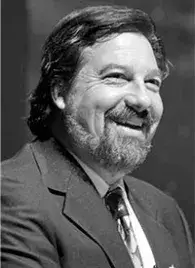
Introduction
The image of the archaeologist as merely a collector of objects is an old one, and this unflattering image unfortunately describes our field in the eighteenth and nineteenth centuries. About a hundred years ago, however, archaeology grew into a systematic natural history, a discipline that straddled the humanities and sciences. Fifty years ago the field continued to evolve with one branch now constituting a comparative behavioral and social science. Scientific archaeology today is now able to tease out some of the most fascinating details in the social evolution of our species.
Many people are amazed to learn that we can now describe with great accuracy the diet of people who lived 10,000 years ago by applying techniques such as isotopic residue analysis and X-ray diffraction to stone tools. We can trace the evolution and history of disease using DNA. We can track human migration by measuring ratios of strontium in people’s teeth and ribs. We can recreate ritual processions using virtual modeling. We can define the effects of human beings on plant and animal evolution by measuring genetic changes. We can model the acoustics of a 5,000-year-old temple using engineering principles. We can detect minute changes in the local climate by analyzing pollen cores from bogs and lakes, and we can define the strategies that people utilized to cope with such changes using agent-based modeling. These and countless other facts about our ancestors help us more fully understand social evolution. All of these innovations have been driven by new technologies that allow us constantly to expand our ability to dig deeper to discover new data.
Professor Thomas Levy represents the best of this tradition, being first a great field archaeologist and accomplished theoretician who understands the appropriate role of technology in science and model building. Too many of our colleagues find a really nice toy and then try to find the scientific questions to fit it. Tom, one of the few among us who has eagerly grasped the potential of these new technologies, understands that you have to use the appropriate technology for the appropriate research design. Tom is Distinguished Professor and Norma Kershaw Chair in the Archaeology of Ancient Israel and Neighboring Lands at the University of California, San Diego. He is also a member of the Department of Anthropology and the Judaic Studies Program, and he leads the Cyber Archaeology Research Group at the Qualcomm Institute for Telecommunications and Information Technology, the UC San Diego Division of Calit2.
Elected to the American Academy in 2008, Tom is one of the leading archaeologists interested in the role of technology and social evolution. He not only uses technology, he studies it. He is particularly interested in early mining and metallurgy and is a leading theorist of modeling human social interactions from the beginning of what we call the sedentary life of our species, around 9,000 years ago, to the rise of the first historic Levantine state societies in the Iron Age circa 1200 BCE. He is a Fellow of the Explorer’s Club, and he won the 2011 Lowell Thomas Award for exploring the world’s greatest mysteries. He has been the principal investigator on numerous interdisciplinary archaeological field projects in Israel and Jordan funded by many institutions, including National Geographic, the National Endowment for the Humanities, and the National Science Foundation, as well as by private donors. Tom also conducts contemporary research in India with his wife, Alina Levy. They recently coauthored Masters of Fire: Hereditary Bronze Casters of South India. Tom has published ten books and several hundred research articles. His most recent book, Historical Biblical Archaeology: The New Pragmatism, won the Best Scholarly Book Award from the Biblical Archaeological Society.
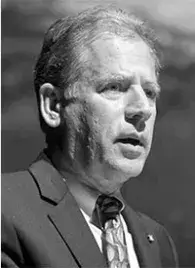
Presentation
Toward the end of 2010 members of the U.S. Senate and House of Representatives issued a bipartisan call for the American Academy of Arts and Sciences to respond to the following question:
What are the top actions that Congress, state governments, universities, foundations, educators, individual benefactors, and others should take now to maintain national excellence in humanities and social scientific scholarship and education, and to achieve long-term national goals for our intellectual and economic well-being; for a stronger, more vibrant civil society; and for the success of cultural diplomacy in the 21st century?
Today, my graduate students, colleagues, and I are helping to demonstrate how archaeology, as practiced at research universities in the United States, can help respond to this bipartisan call.
Specifically, interdisciplinary collaborations here at UCSD among faculty, graduate students, and undergraduates working on international projects are developing a twenty-first-century version of archaeology, what I like to call “cyber-archaeology.” It can play an important role in helping to promote excellence in the humanities and social sciences by addressing scholarship that focuses on world cultural heritage.
We should remember that, like natural resources, cultural resources are limited. As scholars, our responsibility is to conduct research, but also to disseminate information to promote national and international pride in cultural heritage and help facilitate national and international efforts that harness cyber-archaeology for conservation and tourism needs.
In 1994 UNESCO’s World Heritage Committee launched a global strategy for a representative, balanced, credible World Heritage List for the protection of cultural and natural sites. Today, 962 properties around the world, including 745 cultural, 188 natural, and 29 mixed properties, have passed the rigorous nomination process. Examples in the United States include Mesa Verde National Park, Yellowstone, and Hawaii Volcanoes National Park. In the United Kingdom, Stonehenge, the city of Bath, and the old and new towns of Edinburgh come to mind. In Jordan, where I work, the Nabataean rose-red city of Petra, seen in the Indiana Jones movie The Last Crusade, is the most famous on the list. My research area in Jordan, which is 30 kilometers northwest of Petra, is now on the list to become a UNESCO biosphere reserve.
While natural resources often have a chance for renewal, this is not the case with cultural resources. They are always in danger of destruction from natural processes and human actions – actions such as the recent pillaging of Sufi Islamic heritage in Mali and the Taliban’s destruction of the famous Bamiyan Buddha statues in Afghanistan in 2001.1 The Afghan government has been working with cyber-archaeologists to use laser scans to reconstruct the massive Bamiyan statues.2 This is just one of the ways cyber-archaeology can offer answers to issues raised by researching and conserving cultural heritage. In fact, cyber-archaeology offers answers not only for archaeology but for other field sciences, including geology, ecology, biology, oceanography, and more.
Cyber-archaeology refers to the integration of the latest developments in computer science, engineering, science, and archaeology. UCSD is uniquely situated to help advance cyber-archaeology because of its unparalleled, interdisciplinary research focus, as exemplified by the Qualcomm Institute for Telecommunications and Information Technology, the UC San Diego Division of Calit2. Within the institute, I am part of a $3.2 million grant awarded by the National Science Foundation’s Integrative Graduate Education and Research Traineeship Program, otherwise known as IGERT. My colleague Falko Kuester, a structural engineer and computer scientist from UCSD’s Jacobs School of Engineering, is principal investigator. Talented faculty, students, and staff working with powerful computer-based analytical facilities in Calit2 enable us to explore new directions in research, scholarship, and teaching.3
The Harvard Business School is using the Qualcomm Institute, the UC San Diego Division of Calit2, as a case study of how the twenty-first-century research university should be structured, and it points to the unique academic atmosphere we enjoy here. With regard to cyber-archaeology, our graduate students are harnessing the power of the information technology revolution to answer high-level research questions facing the humanities and social sciences. My own archaeological research in Jordan and Israel is rooted in an interdisciplinary approach that straddles anthropology, Judaic studies, history, computer science, and engineering. Over the past six years, my engagement with Calit2, and specifically with its Center of Interdisciplinary Science for Art, Architecture and Archaeology (CISA3), where I am Associate Director, has dramatically changed how we think of archaeology. The Director of the Qualcomm Institute, the UC San Diego Division of Calit2, Ramesh Rao, has encouraged us to develop cyber-archaeology as a distinct, twenty-first-century approach to the study of world cultural heritage.
At UCSD and other research universities in the United States, scholars in the social sciences cannot rest on the twentieth-century achievements that made these institutions the best in the world. In its letter to the American Academy of Arts and Sciences, Congress stated that it is concerned that the tradition – and here I suggest, the tradition of great achievements in the humanities and social sciences that began in the twentieth century – is at risk. This puts the unique American character at risk as well. As pragmatists, social science researchers in the United States must engage with the digital revolution to make their research relevant and useful to solve problems. My UCSD political science colleague James Fowler, who is also in the UCSD School of Medicine, recently carried out an experiment on Facebook that focused on Election Day in November 2012. He sampled 61 million Facebook users. This is a great example of twenty-first-century social science research. However, while there is such a thing as the digital humanities, you rarely hear the term digital social sciences. Yet cyber-archaeology harnesses the benefits of computer science and engineering to tackle the needs of world cultural heritage research and conservation, and I believe that cyber-archaeology can contribute to building “digital social sciences” here at UCSD.
To conceptualize what cyber-archaeology is all about, think of it as a pie chart (see Figure 1). Basically, it involves the acquisition, curation, analysis, and dissemination of data. This is common to all field sciences, but our work in cyber-archaeology provides a model for the present and the future. In terms of acquisition, what drives research is the set of humanistic and social science questions that we want to answer.4 That is where it all begins.
| Figure 1. Workflow model for cyber-archaeology developed at the University of California, San Diego. The model is applicable to any field science. |
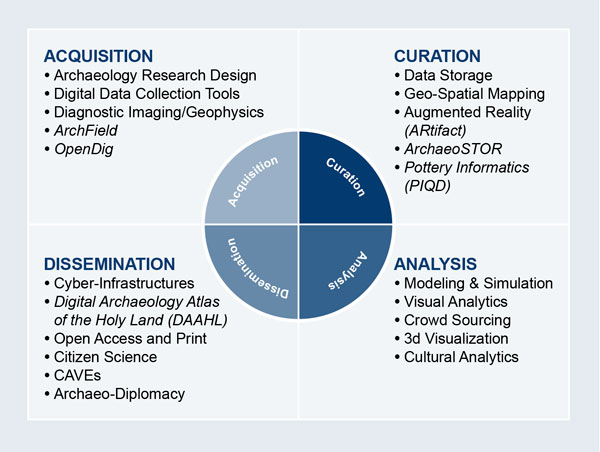 |
In our research group, we have focused on developing digital data-collection tools that can be used in the field. Diagnostic imaging and geophysics are also employed. One of our graduate students, Matt Vincent, is developing a program called OpenDig to collect all of the metadata involved in excavating an archaeological site and then serve up that data on a smartphone, tablet, or similar device.
Curation of data involves data storage, geospatial mapping, and augmentation (so-called augmented reality, or AR). Another student, David Vanoni, adds metadata to visual imagery of cultural and historical sites using AR, and Aaron Gidding is responsible for creating ArchaeoSTOR, a relational geospatial database system.
Many of these areas of acquisition and curation are crosscutting; thus, data are used for modeling. We use a wide range of visual analytical tools, and graduate student Andrew Huynh, working with CISA3 researcher Albert Lin, develops online crowd-sourcing solutions that can bring thousands of citizen scientists into the loop.
Visualization is exciting because it allows you to look at cultural artifacts in new ways, and visualization is critical to dissemination because we need to make our data available to our colleagues as well as to the general public.
Thus, cyberinfrastructure is critical for archaeology, and it must be made available for free through an open-source, open-access system. Publishing our results in peer-reviewed journals and books is still crucial. However, other modalities exist for disseminating data arising from twenty-first-century cyber-archaeology. At the Qualcomm Institute, the UC San Diego Division of Calit2, we have 3-D visualization environments, called CAVEs, and we have helped build CAVEs in Saudi Arabia. These efforts represent “archaeo-diplomacy,” because they enable us to create partnerships that make our teams cultural diplomats for the United States in distant lands.
From UCSD, we have carried out a number of cyber-archaeology expeditions in Greece, in Cyprus, and in the Middle East, especially in Jordan, where I work most closely. Our CISA3 team also has projects in Mongolia, Saudi Arabia, and Italy. In Cyprus, I have been involved in a paleomagnetic-dating project with Lisa Tauxe, a professor at UCSD’s Scripps Institution of Oceanography. However, archaeometallurgy is the main focus of our research in Jordan, Israel, and Palestine.
Our principal cyber-archaeology field research is in southern Jordan, in a region called Faynan (after Biblical Punon). That is where, since 1997, I and Jordanian archaeologist Mohammad Najjar have been conducting a deep-time study of the role of technology – in this case, ancient mining and metallurgy – on the evolution of societies. We begin in the Neolithic period (ca. 8,000 BC), work through the urban revolution in the Early Bronze Age (ca. 3000–2000 BC), on to the Iron Age (roughly 1200–500 BC, which is the Biblical period from the time of the Exodus to the destruction of the Temple in Jerusalem), and then to medieval Islamic times. The first local, historic, state-level societies emerged in this region during the Iron Age (ca. 1200–500 BCE).
An aerial image depicts the largest (ca. 24 acres) Iron Age metal factory in the Faynan district, located 50 kilometers south of the Dead Sea. Black slag still covers the surface. A large square structure represents a fortress, and we use ancient metalworking as a kind of proxy to measure social change. We look at the organization of craft production, its context, concentration, and scale of production. This informs us about social organization, and data can also be related to historical sources associated with the ethnogenesis of early Israel, the Edomites, and other peoples connected with this story.
In 1999, several years after I first started to work in Jordan, a friend said, “Why don’t you send a fax to Queen Noor and ask her if she could provide you with a helicopter to do some aerial photography?” Queen Noor was born an American and was married to King Hussein. It took some chutzpah, but I sent her the fax and she responded. “Be at the Marka Air Base on such and such a day, and the Royal Jordanian Air Force will fly you around for a day.” That is when we took our first amazing images around Faynan. However, the experience left me wanting my own aerial photography and mapping system. That dream finally came true ten years later, after I started to collaborate at the Qualcomm Institute.
For archaeologists, and probably for most field scientists, time and space are our most precious commodities. Time because it enables us to measure cultural change, for which we use high-precision radio-carbon dating and Bayesian analysis. Space because we need to know the spatial location of every artifact we find. If you remove an artifact from its context, it has no social meaning. But if we know its setting, then we can begin to build meaningful models of the past. Our group has developed a “digital toolbox” that can be deployed in the field. Total stations and GPS are used to collect precise x, y, and z coordinates that pinpoint the location of every cultural artifact. Aerospace engineering students as part of UCSD’s undergraduate National Geographic Engineers for Exploration program developed a helium balloon system for high-definition aerial photography (see Figure 2). We can use video over Wi-Fi if we want to see what the cameras see from the balloon’s undercarriage while deployed above the dig site. We use portable X-ray fluorescence instruments to characterize artifacts, 3-D scanners to scan each significant artifact we find, and a 3-D visualization system to display the results.
| Figure 2. Helium balloon platform flown at Jordan’s Petra UNESCO World Cultural Heritage site by Matt Howland. The balloon system was developed by undergraduate students as part of the UCSD National Geographic Engineers for Exploration program (Photo: T. E. Levy). |
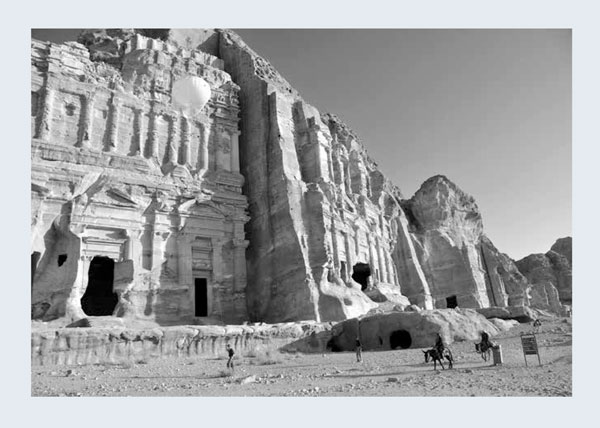 |
In November 2012, the American Center of Oriental Research (ACOR) asked if we would partner with them on a two-day cyber-archaeology expedition in the area to create georeferenced aerial photographs, 3-D maps, LiDAR, and AR of the center of Petra. The results were astounding thanks to the graduate students who were with us in the field for this project, which was carried out in partnership with Jordan’s Department of Antiquities. We developed a system for 3-D “rescue laser scanning” with Ashley Richter, using software developed by another student, Vid Petrovic. Figure 3 shows the iconic Treasury (al-Khazneh in Arabic), considered the most magnificent of Petra’s sights, as visualized with our software.5 Here, LiDAR is used as a conservation tool, which is how most people today use LiDAR, because it collects millions of georeferenced data points that together portray exactly what an area looked like on the day it was scanned. Since that date, the area may have degraded, and by comparing LiDAR scans from two time periods, we can learn a lot about the rate of decay – and begin to consider ways to counteract it.
| Figure 3. LiDAR model of the Petra Treasury, enhanced with Calit2 graduate student programming (data courtesy of the Jordanian Department of Antiquities). |
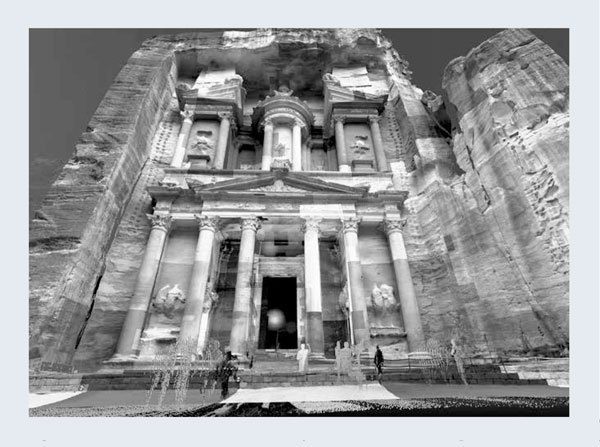 |
At Khirbat en-Nahas (Arabic for “ruins of copper”), our site in the Faynan district in southern Jordan, our students carried out three weeks of LiDAR scanning with Tom Wypch. We wanted to date the fortress by 3-D plotting high-precision radiocarbon dates in relation to walls and layers we excavated at the site. Vid Petrovic’s program essentially created a scaffold on which we could embed different kinds of archaeological spatial data. By doing this, we could see when the foundation of the monumental fortress came into existence. From this, we now know definitively that it was constructed in the tenth century BC. This is interesting because many scholars have said that no local complex societies existed in the southern Levant during that century; that would mean that there was no impressive Solomonic or Edomite kingdom, for example. What we proved was that, yes, impressive, local state-level societies capable of building fortresses like Khirbat en-Nahas were present in the desert zone during the tenth century BC.
In the area of curation, we have integrated data storage, geospatial mapping, and augmentation with the program ArchaeoSTOR. This helps us record and organize data both in the field and when we get back home. Measured in gigabytes since 2007, our collection of digital data has grown exponentially from 172 GB to 2,055 GB in 2011. Last fall, the volume of data went down slightly, but that is because data storage is not really our big problem. Today, you can go to the campus bookstore and buy a two- or three-terabyte drive for a few hundred dollars. The hard part is taking the disparate kinds of field data and melding them together to test your hypothesis. So we have been working with the UCSD-based San Diego Supercomputer Center and the UCSD Libraries in their Research Cyberinfrastructure program.6 Our lab is one of their five pilot projects. What we all have in common is an interest in the geospatial organization of data, whether massive sets of seismic data, deep-sea cores from oceans around the world, or thousands of artifacts geospatially organized from our excavation sites. Thus, all field sciences deal with the same problem.
Internet connectivity is difficult when you are working in a remote desert area such as our sites in southern Jordan. ArchaeoSTOR, a kind of cloud-based service model, basically mirrors the Web until we get back home.
How can we bring all these kinds of data together to help solve specific historical problems? When we were digging at Khirbat en-Nahas, we decided to sample one of the slag mounds by excavating a large (greater than 5-by-5-square-meter) area down to bedrock. We went down more than 24 feet, layer by layer, collecting artifacts, slag, and organic remains for high-precision radiocarbon dating. This stratigraphic “core” enabled examination of the intensity of metal production through time. It became clear that we were looking at industrial-scale copper production over a very short period of time: the tenth and ninth centuries BC. Yet we had over two-and-a-half meters of industrial slag for each radiocarbon-dated century – indicating that a complex society (kingdom/archaic state) was processing metal. The artifacts showed that it was a local Levantine society – not from the neighboring centers of Egypt, Mesopotamia, or Anatolia. So again we have shown that in the tenth century BC, in the Biblical time of Solomon, the early Israelites and Edomites, local kingdoms were involved in these activities. We first published these interdisciplinary findings in the Proceedings of the National Academy of Sciences in 2008.7
Dissemination of cyber-archaeology involves issues such as open access, citizen science, and archaeo-diplomacy. One collaboration in this area is between Calit2 and King Abdullah University of Science and Technology (KAUST) in Saudi Arabia. KAUST wanted to build something like the MIT Media Lab or the Qualcomm Institute, with visualization environments for large-scale or 3-D immersive visualization and virtual reality. Calit2’s bid was accepted, and my colleague, and Calit2’s director of visualization, Tom DeFanti, led the successful effort to build scientific visualization facilities at KAUST, many of which were completed in time for the university’s grand opening in 2009. This was an excellent example of inventing a persistent collaborative research and education environment as a model for the major research university in the twenty-first century, which is what the Saudis wanted.
People instinctively understand archaeology and history; it resonates with them. So, to demonstrate the power of 3-D scientific visualization at the KAUST opening in 2009, we used our Jordanian data in the new visualization lab to highlight cultural heritage research. We demonstrated a 3-D fly-through of the deepest slag section at the Jordanian site, allowing visitors to experience a visual representation of thousands of artifact data points captured in that excavation and compiled by our graduate student Kyle Knabb.
We have also been developing the Mediterranean Archaeological Network, or MedArchNet, with Stephen Savage from Arizona State University. This cyberinfrastructure project is a work in progress, and we envision having a number of digital atlas “nodes” of the network around the Mediterranean. The infrastructure would house geospatial data and other information about the antiquities of countries in each region, all accessible through a Web portal. We have already created the Digital Archaeological Atlas of the Holy Land (DAAHL), which covers Israel, Jordan, and the Palestinian Territories. At UCSD alone, we have amassed 30 tons of artifacts. Another eight tons of material are in transit from Aqaba to UCSD. We don’t know where we are going to put it all, but DAAHL enables us to share the data online over a Google Earth georeferenced platform in a virtual museum.8
In conclusion, cyber-archaeology provides an integrated approach to dealing with the essential processes associated with field science: data acquisition, curation, analysis, and dissemination. By engaging with the study of many of the major transformations in human history, interdisciplinary archaeology is one of the few disciplines that intersects not only with the humanities and social sciences but with the hard sciences, engineering, and even the health sciences (e.g., in the form of ancient DNA). Since the end of the Pleistocene, around 10,000 BC, humankind has been transformed by a wide range of technological revolutions, among them the Neolithic revolution, the metals revolution, the Industrial Revolution, the information technology revolution, and more. Some argue that today we are in the midst of a nanotechnology revolution. Archaeology’s special focus on the material world of human culture has made it pre-adapted to engage with the digital revolution, thanks to the benefits that data mining, scientific visualization, and other IT tools are bringing to scholarly research, exploration, and society.
With the exponential increase in the global use of digital technologies, including cell phones and the Internet, it is essential that in the United States the humanities and social sciences incorporate digital technologies as integral parts of our pedagogy, research, and outreach if we are to maintain excellence in these fields in the twenty-first century – and respond to Congress’s appeal to the Academy. Perhaps we will now witness the advent of “digital social sciences.” At UCSD, our researchers are collaborating through cyber-archaeology to help maintain national excellence in enhancing international cultural heritage – an area that unites the humanities and the social sciences. Through best practices, we believe our work also contributes to cultural diplomacy by utilizing the most advanced digital tools available for testing cultural and historical questions.
ENDNOTES
1 On the destruction in Mali, see Emily O’Dell, “Slaying Saints and Torching Texts,” Jadaliyya, February 1, 2013, http://www.jadaliyya.com/pages/index/9915/slaying-saints-and-torching-texts.
2 Claudio Margottini, ed., After the Destruction of Giant Buddha Statues in Bamiyan (Afghanistan) in 2001 (New York: Springer, 2013).
3 Thomas E. Levy, Neil G. Smith, Mohammad Najjar, Thomas A. DeFanti, Albert Yu-Min Lin, and Falko Kuester, Cyber-Archaeology in the Holy Land: The Future of the Past (Washington, D.C.: Biblical Archaeology Society eBook, 2012), http://www.biblicalarchaeology.org/get-ebook/?download_this_freemium=20844.
4 Kent V. Flannery and Joyce Marcus, The Creation of Inequality: How Our Prehistoric Ancestors Set the Stage for Monarchy, Slavery, and Empire (Cambridge, MA: Harvard University Press, 2012).
5 We are grateful to Jehad Haroun and Tawfiq al-Haiti of the Department of Antiquities for sharing these LiDAR data.
6 For information on this project, see http://rci.ucsd.edu/data-curation/pilots.html.
7 Thomas E. Levy, Thomas Higham, Christopher Bronk Ramsey, Neil G. Smith, Erez Ben-Yosef, Mark Robinson, Stefan Münger, Kyle Knabb, Jürgen P. Schulze, Mohammad Najjar, and Lisa Tauxe, et al., “High-Precision Radiocarbon Dating and Historical Biblical Archaeology in Southern Jordan,” Proceedings of the National Academy of Sciences 105 (43) (2008): 16460–16465.
8 To view the atlas, see http://daahl.ucsd.edu/DAAHL.
© 2013 by Charles S. Stanish and Thomas Levy, respectively